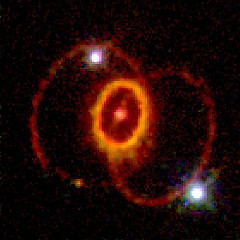

|
The International Conference
|
Abstract Most current supernova theories state that this phenomenon lasts a few seconds and ends with a big final explosion. However, these theories do not take into account several experimental results obtained with neutrino and gravitational wave detectors during the explosion of SN1987A, the only supernova observed in a nearby galaxy in modern age. According to these experimental results the phenomenon is much more complex that envisaged by current theories, and has a duration of several hours. Indeed, SN1987A exploded on February 23, 1987, and two neutrino bursts, separated by 4.7 hours were detected: the first one at 2h 52m UT and the second one at 7h 35m UT. Furthermore, correlations between the neutrino and two gravitational wave detectors, ignored by most of the scientific community, were observed during the longer collapse time. Since the current standard theories, based on some rough simplifications, are a clear example of an Aristotelian attitude, still present in our days, we believe that a more Galilean attitude is necessary, being the only correct way for the progress of science.
Reference:
|